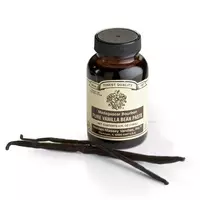Vanilla paste

The pleasant aroma of vanilla, along with its masking and deodorizing abilities, led to the fact that more and more of this natural plant raw materials were required in the food industry. The main field of its application is the aromatization of various products - ice cream, chocolate, alcoholic and soft drinks, pastries and confectionery, dairy products, as well as tobacco.
It is clear that it is impossible to use ordinary green vanilla in mass production conditions - it is much more convenient to use a product with uniform characteristics. That is why many countries have taken the path, in particular the United States, where industrial production of concentrate, extract and paste with a characteristic vanilla aroma has been established. At the same time, ease of use has made these products unusually popular in home cooking too.
For example, it is customary to call vanilla paste a concentrated taste paste, which (according to manufacturers) includes exclusively natural vanilla pods, as well as a natural extract of this plant along with identical natural aromatic substances. Externally, vanilla paste is a rather thick liquid, which is distinguished by a saturated orange color and vanilla aroma.
You can buy vanilla paste today in specialized stores at a very reasonable price. On the packaging of this product you can always find its composition, which contains glucose syrup, sugar, pectin solution, vanilla pods, 100% natural vanilla extract, citric acid (acidity regulator), as well as dyes: riboflavin and beta-carotene.
Nevertheless, according to experts, one should not be under illusions about what is written on the packaging - vanilla paste, as a rule, is made from the remains of production. In other words, vanilla pods are used for its production, which have not passed strict quality selection in the process of making commercial vanilla. These are mostly damaged, small, overripe, cracked or over-dried vanilla pods.
It's worth noting that vanilla paste can give your confectionery a distinctive vanilla aroma. In addition, due to its consistency, vanilla paste is convenient to use: it can be added to almost any sweet dish. In particular, vanilla paste is used as a taste and aroma additive in the preparation of various types of creams, gels, mousses, dough.
In addition, it is used for tinting and flavoring protein or whipped cream, jelly, milkshakes, drinks, ice cream. This paste can be impregnated with cake bases, as well as added to candy fillings. Another advantage of vanilla paste is that it is very economical to use - for example, it is recommended to use about 40-50 grams of this concentrate per kilogram of dish.
vanilla paste 283 kCal
Energy value of vanilla paste (Ratio of proteins, fats, carbohydrates - ju):
Proteins: 0 g (~ 0 kCal)
Fats: 0 g (~ 0 kCal)
Carbohydrates: 70g (~ 280kCal)
Energy ratio (b | y): 0% | 0% | 99%
 Español
Español Français
Français Português
Português Русский
Русский 简体中文
简体中文 繁體中文
繁體中文 日本語
日本語 한국어
한국어 العربية
العربية Türkçe
Türkçe Қазақ
Қазақ Deutsch
Deutsch Italiano
Italiano Українська
Українська
